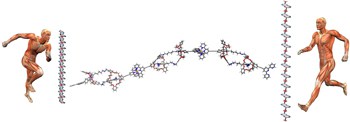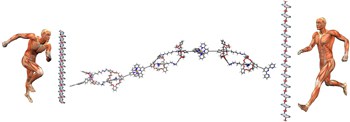
Biology uses various types of molecular machines to produce movement, all of which are candidates to be mimicked for use in nanotechnology. Muscles produce movement through the contraction of systems of polymers, powered by the release of chemical energy. Now scientists from France’s CNRS have developed an artificial muscle that produces micrometer-scale movement through the coordinated action of thousands of individual molecular machines each producing nanometer-scale movement. A hat tip to Gene Ostrovsky at MedGadget for a story on this CNRS press release “Assembly of nano-machines mimics human muscle“:
For the first time, an assembly of thousands of nano-machines capable of producing a coordinated contraction movement extending up to around ten micrometers, like the movements of muscular fibers, has been synthesized by a CNRS team from the Institut Charles Sadron. This innovative work, headed by Nicolas Giuseppone, professor at the Université de Strasbourg, and involving researchers from the Laboratoire de Matière et Systèmes Complexes (CNRS/Université Paris Diderot), provides an experimental validation of a biomimetic approach that has been conceptualized for some years in the field of nanosciences. This discovery opens up perspectives for a multitude of applications in robotics, in nanotechnology for the storage of information, in the medical field for the synthesis of artificial muscles or in the design of other materials incorporating nano-machines (endowed with novel mechanical properties). This work has been published in the on-line version of the journal Angewandte Chemie International Edition [abstract].
… Even though synthetic chemists have made dazzling progress over the last few years in the manufacture of artificial nano-machines (the mechanical properties of which are of increasing interest for research and industry), the coordination of several of these machines in space and in time hitherto remained an unresolved problem.
Not anymore: for the first time, Giuseppone’s team has succeeded in synthesizing long polymer chains incorporating, via supramolecular bonds (1), thousands of nano-machines each capable of producing linear telescopic motion of around one nanometer. Under the influence of pH, their simultaneous movements allow the whole polymer chain to contract or extend over about 10 micrometers, thereby amplifying the movement by a factor of 10,000, along the same principles as those used by muscular tissues.
… These results, obtained using a biomimetic approach, could lead to numerous applications for the design of artificial muscles, micro-robots or the development of new materials incorporating nano-machines endowed with novel multi-scale mechanical properties.

A different flavor of nanotechnology involving nanostructures that are not defined to atomic precision has produced a different type of artificial muscle that looks very robust in that it does not require changing solutions of electrolytes, responds very quickly, and is far stronger than human muscles of the same size. These muscles are composed of a yarn of carbon nanotubes filled with wax. The research was published in Science [abstract]. A hat tip to KurzweilAI for reprinting this news release from UT Dallas “Wax-Filled Nanotech Yarn Behaves Like Super-Strong Muscle“:
New artificial muscles made from nanotech yarns and infused with paraffin wax can lift more than 100,000 times their own weight and generate 85 times more mechanical power than the same size natural muscle, according to scientists at The University of Texas at Dallas and their international team from Australia, China, South Korea, Canada and Brazil.
The artificial muscles are yarns constructed from carbon nanotubes, which are seamless, hollow cylinders made from the same type of graphite layers found in the core of ordinary pencils. Individual nanotubes can be 10,000 times smaller than the diameter of a human hair, yet pound-for-pound, can be 100 times stronger than steel.
“The artificial muscles that we’ve developed can provide large, ultrafast contractions to lift weights that are 200 times heavier than possible for a natural muscle of the same size,” said Dr. Ray Baughman, team leader, Robert A. Welch Professor of Chemistry and director of the Alan G. MacDiarmid NanoTech Institute at UT Dallas. “While we are excited about near-term applications possibilities, these artificial muscles are presently unsuitable for directly replacing muscles in the human body.”
Described in a study published in the Nov. 16 issue of the journal Science, the new artificial muscles are made by infiltrating a volume-changing “guest,” such as the paraffin wax used for candles, into twisted yarn made of carbon nanotubes. Heating the wax-filled yarn, either electrically or using a flash of light, causes the wax to expand, the yarn volume to increase, and the yarn length to contract.
The combination of yarn volume increase with yarn length decrease results from the helical structure produced by twisting the yarn. A child’s finger cuff toy, which is designed to trap a person’s fingers in both ends of a helically woven cylinder, has an analogous action. To escape, one must push the fingers together, which contracts the tube’s length and expands its volume and diameter.
“Because of their simplicity and high performance, these yarn muscles could be used for such diverse applications as robots, catheters for minimally invasive surgery, micromotors, mixers for microfluidic circuits, tunable optical systems, microvalves, positioners and even toys,” Baughman said.
Muscle contraction – also called actuation – can be ultrafast, occurring in 25-thousandths of a second. Including times for both actuation and reversal of actuation, the researchers demonstrated a contractile power density of 4.2 kW/kg, which is four times the power-to-weight ratio of common internal combustion engines. …
“The remarkable performance of our yarn muscle and our present ability to fabricate kilometer-length yarns suggest the feasibility of early commercialization as small actuators comprising centimeter-scale yarn length,” Baughman said. “The more difficult challenge is in upscaling our single-yarn actuators to large actuators in which hundreds or thousands of individual yarn muscles operate in parallel.”
Additional coverage, including a video of these micro-muscles in action, is included in Science News coverage by Sarah C. P. Williams “Wax-Filled Nanotubes Flex Their Muscles“. These two very different approaches to providing nanoscale motion that can scale to microscale or even macroscale robotic motion have different features that will probably suit them to different applications. It will be interesting to see if any applications are developed that will be relevant to nanoscale atomically precise manufacturing.
—James Lewis, PhD
